vivo X100 can be said to be the mobile phone I am most looking forward to in the second half of this year. The reason is very simple. Starting from the X80, vivo has fully equipped the standard model of the X series with full configuration experience, and will not “cut off” key configurations. “One knife.” Another reason is that the flagship core of the MediaTek platform was launched for the first time, and “equal treatment” was achieved. Fa Ge’s optimization of the blue factory is also obvious to the majority of consumers.
Coupled with the fact that the vivo X series has always been very sincere in terms of imaging, naturally this year’s X100 series has become the product I am most looking forward to.
Therefore, this article also talks about the just-released Vivo X100 standard version mobile phone. Especially after a period of hands-on experience, in the author’s opinion, even the standard version of vivo X100 can still be called a perfect score. Flagship, perfect score.
Design and Appearance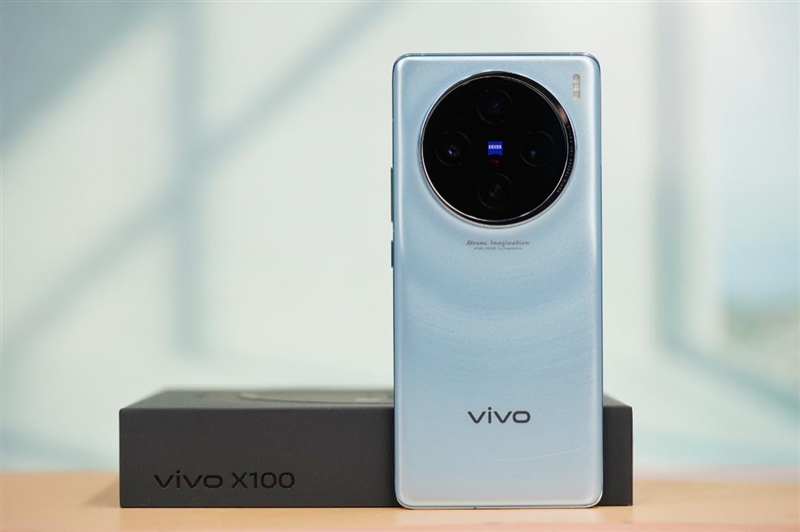
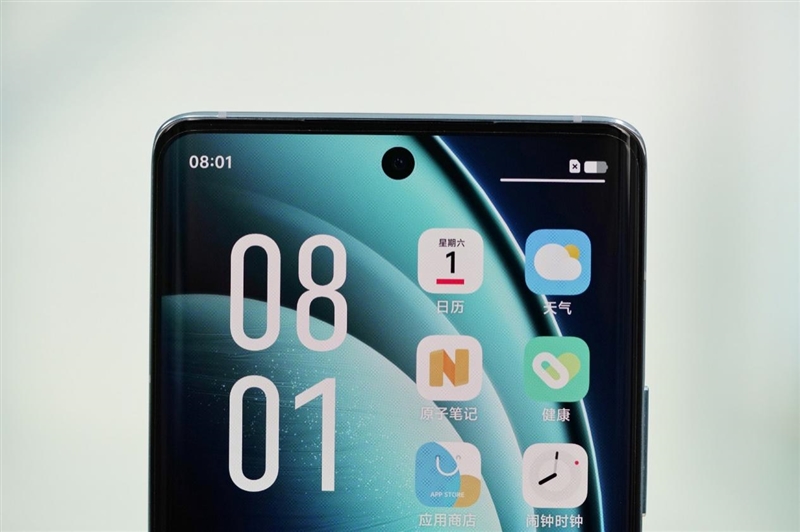
Vivo X100 does not continue the classic “waistline” design of the X90 series. Let me say a few more words here. According to the author’s observation, when the X90 was first released a year ago, many people felt that the “ribbon cloud-step” waistline design was a bit abrupt. However, after a year of testing, most of these controversies have turned into “Good reviews”, it is obvious that this is a temperament product.
Therefore, vivo X100 still continues the unique “temperament” of the X series mobile phones. Although it has returned to the common choice of industry imaging flagship phones – the large ring design, vivo X100 still makes its own unique contribution. resolution.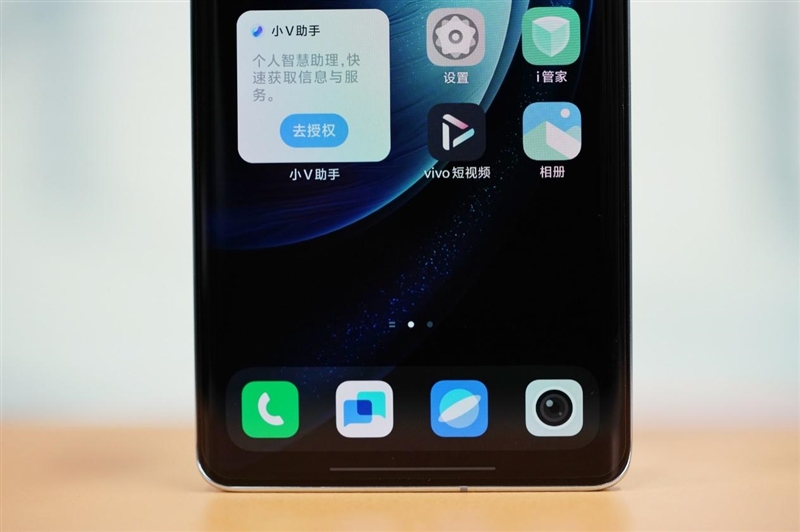
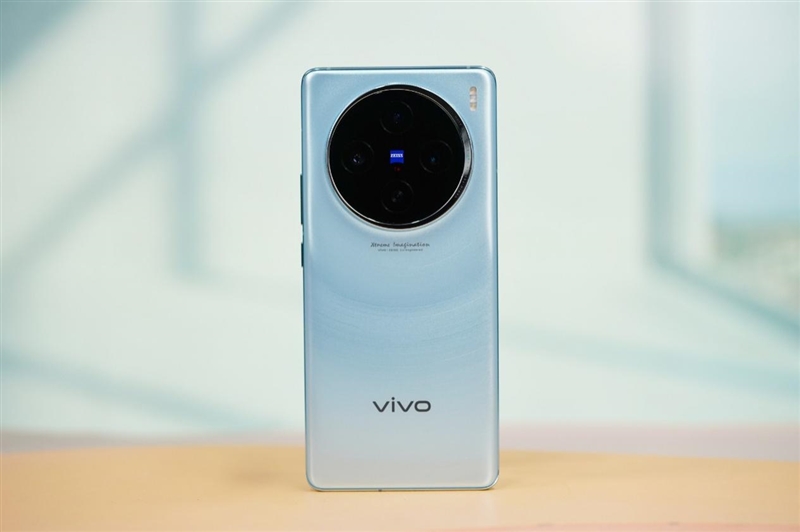
This recognition comes from two aspects: the moon ring cloud level module, and the new smart color matching.
Specifically, the circular module on the back of vivo X100 is not a traditional “big ring”, but a moon ring-shaped metal deco, which wraps the entire circular lens, like a moon ring on top, embracing the lens module. Group.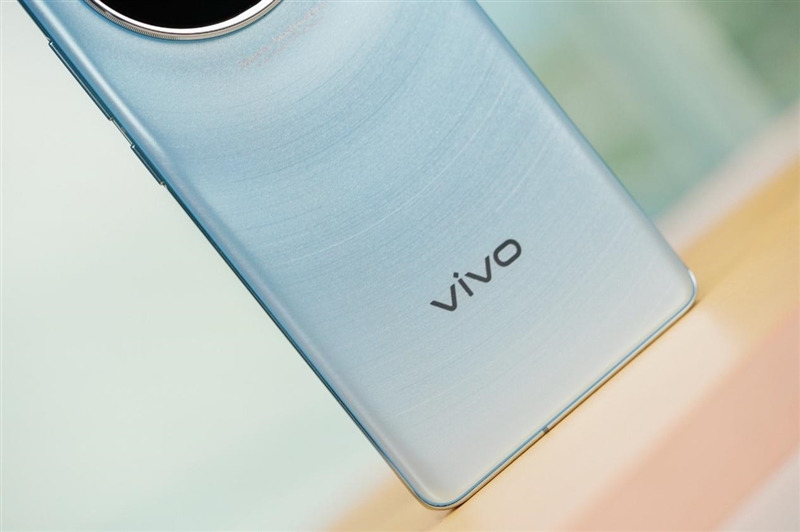
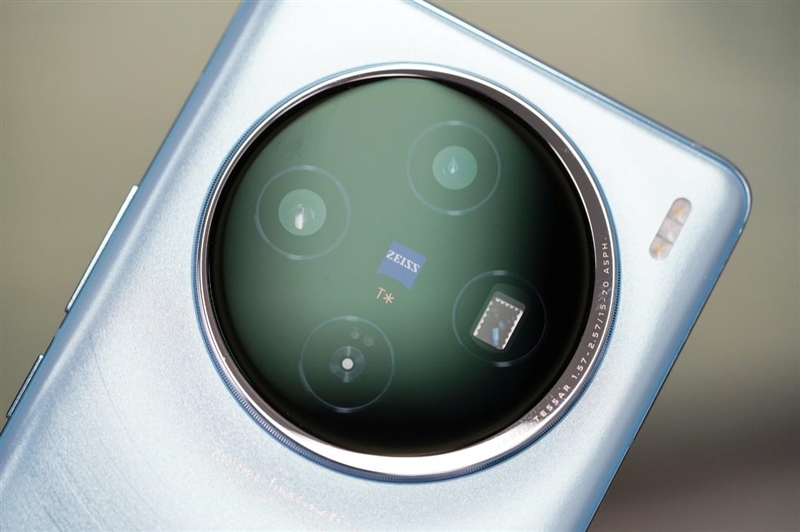
The metal deco is designed with aviation-grade mirror stainless steel, and the outermost side has a metal texture similar to that on a classic watch. The entire module uses 2.5D round lenses, which are not flat and look like water droplets full of tension, with excellent texture.
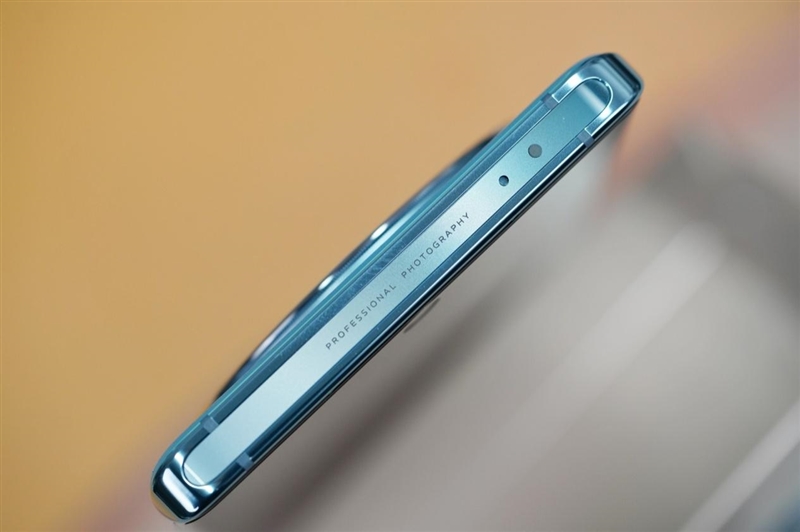
This asymmetrical “moon ring shape” may make many friends with obsessive-compulsive disorder feel “awkward”, but it is precisely this asymmetrical “moon ring shape” that makes vivo X100 stand out from the “big ring” This common design feature shows its unique personality.
In addition, I would like to mention that the X100 Pro adopts a “solar ring cloud step” design, embracing the lens module from bottom to top, just like a solar eclipse. These small detail changes also give a certain degree of distinction between X100 and X100 Pro.
In terms of color matching, vivo X100 provides four colors: Star Trail Blue, Sunset Orange, White Moonlight, and Chenye Black (but the classic “Chinese Red” is gone, and I hope it will appear on the X100 Pro +). Each of the four colors The models are all very bright and recognizable.
Take the Star Trail Blue actually shot by IT Home as an example. This is a light blue color with a bit of cyan. In terms of technology, vivo used star trails as design inspiration and reproduced it through photolithography on the back shell. There are countless delicate star track textures, and the star track track and the moon ring cloud steps are in the same center of the circle, just like the starry sky after a long exposure, which has a strong visual impact. The smart star track lines also give the product a very unique look. High degree of recognition.
There is also the sunset orange color scheme which is my personal favorite. It does not use the traditional plain leather texture but presents a “water ripple” texture, like the sparkling water under the setting sun.
Back to the front, the vivo X100 is equipped with a 6.78-inch Super Retina 8T eye protection screen, using an 8T LTPO backplane. The biggest highlight of this screen is its extremely high peak brightness, reaching 3000nit, whether it is used outdoors or for HDR viewing. Ultra-high brightness brings an excellent experience.
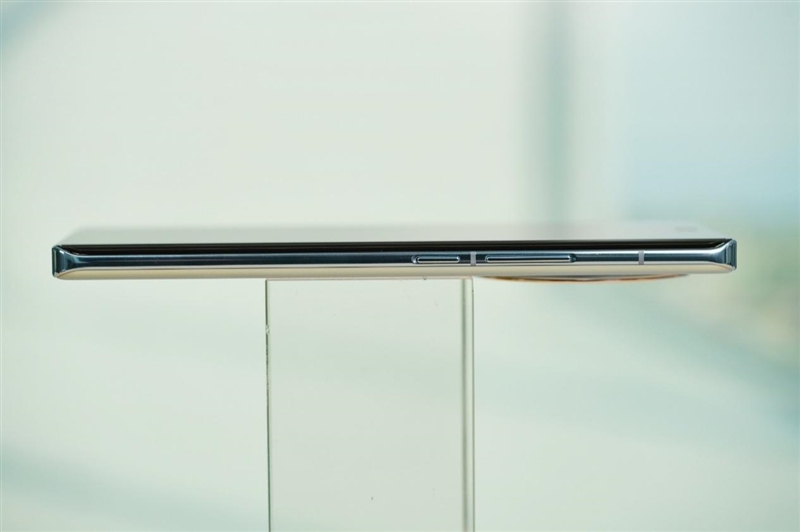
In other respects, this screen has a resolution of 2800×1260, a pixel density of 452ppi, and 2160Hz high-frequency dimming.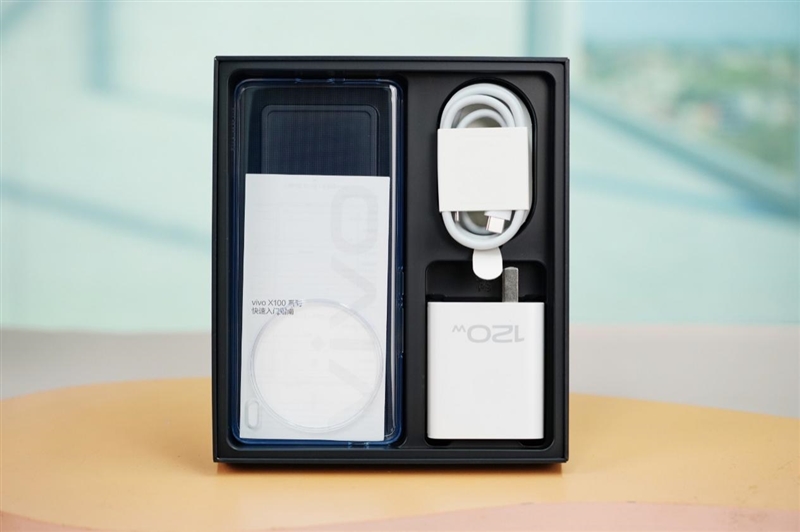
In terms of design, the screen of the vivo X100 is still a traditional curved screen. The curvature is not large, but it does not use a four-sided slightly curved screen. This is not a shortcoming, but the X series curved screen should be appropriately modified after so many years. Let’s design the screen shape.
At least the four sides of the slightly curved screen are guaranteed to feel and look good. The top of the vivo X100 fuselage is the familiar glass deco. Vivo has continued this design since the X50 era. The bottom is the speaker, charging port, and SIM card slot.
The body size of the vivo X100 is 164.05mm × 75.19mm × 8.49mm, and the weight is 206g . The Sunset Orange (vegetable leather) is slightly lighter, about 202g. It has an equivalent 5000mAh Blue Ocean battery packed inside and supports 120W dual-core flash charging.
In addition, features such as stereo dual speakers, full-scene NFC, infrared remote control, and X-axis linear motors are all available. Since the emphasis is on perfect works, vivo X100 also supports IP68 dustproof and waterproof, which is rare in the standard version.
Hardware and Performance
The first two products have proved to the entire industry the indisputable fact that “Fa Ge optimizes by looking at blue factories”, so the Vivo X100 is the most suitable for launching the Dimensity 9300 both emotionally and rationally.
Everyone should have a certain understanding of the Dimensity 9300 chip. Its biggest highlight is its adoption of a CPU full-core architecture design.
Specifically, it contains 4 Cortex-X4 ultra-large cores with a maximum frequency of 3.25GHz and 4 Cortex-A720 large cores with a main frequency of 2.0GHz. Its peak performance is 40% higher than the previous generation and power consumption is saved. 33%.
In the GPU part, Dimensity 9300 takes the lead in adopting the new generation flagship 12-core GPU Immortalis-G720. Compared with the previous generation, the peak performance is increased by 46% and the power consumption is saved by 40% under the same performance.
The most intuitive benefit brought by the full-core CPU architecture is naturally higher performance.
In the AnTuTu V10 version, the comprehensive running score of Dimensity 9300 in a normal temperature environment exceeded 2,130,000 points, and in the laboratory environment, it even exceeded 2,200,000 points, ranking first in the industry. At the same time, in GeekBench 6, the single-core score reached 2203 points, and the multi-core score reached a record-breaking 7616 points, which is also the first in the industry.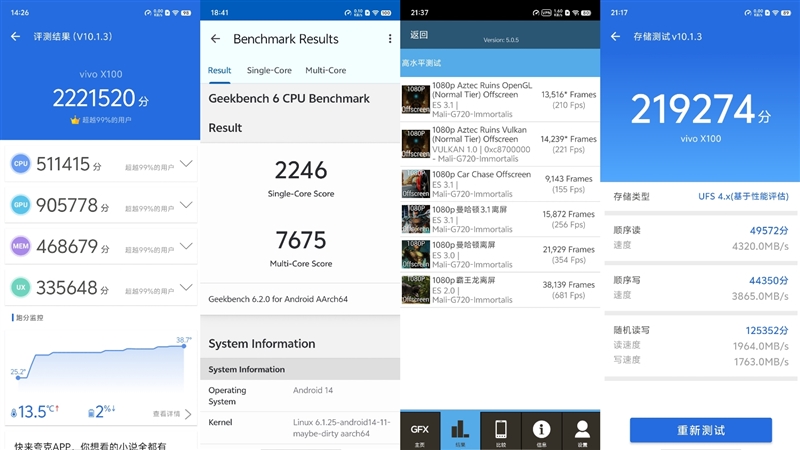
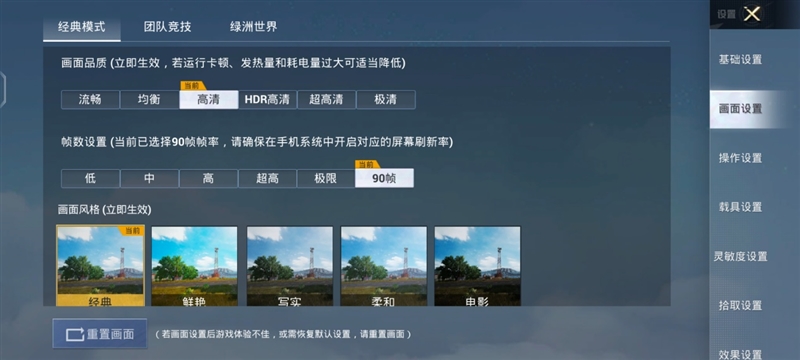
In addition, Dimensity 9300 is the first to support LPDDR5T 9600Mbps memory, which also greatly helps the performance experience during actual experience. The current 16GB+1TB top version of vivo X100 is equipped with LPDDR5T.
For a more detailed introduction to the Dimensity 9300, you can click on IT Home’s article “ Interpretation of the Dimensity 9300 Platform: The Arrival of the All-Big Core Era, MediaTek’s Decisive Blow ” to learn more. The old rule is to test the performance part first.
The first is AnTuTu (v10.1.3). Vivo X100 directly scored an astonishing score of 2209891, exceeding 2.2 million! You should know that this is a test in a normal temperature environment (room temperature is about 20°C).
In terms of storage performance, through the AnTuTu storage test, the vivo X100 has a sequential read speed of 3955.0 MB/s, a sequential write speed of 3888.7MB/s, a random read speed of 2273.0 MB/s, and a random write speed of 1708.0 MB/s.
Like AnTuTu’s benchmark scores, the vivo X100’s storage performance is unmatched.
Let’s take a look at the actual running scores of GeekBench 5 and 6. In GeekBench 5, the vivo X100 scored 1631 points in single-core and 7030 points in multi-core. In GeekBench6, the vivo X100 scored 2260 points in single-core and 7556 points in multi-core.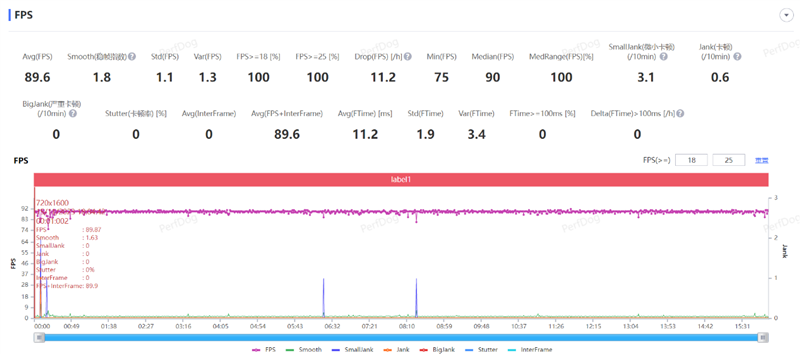
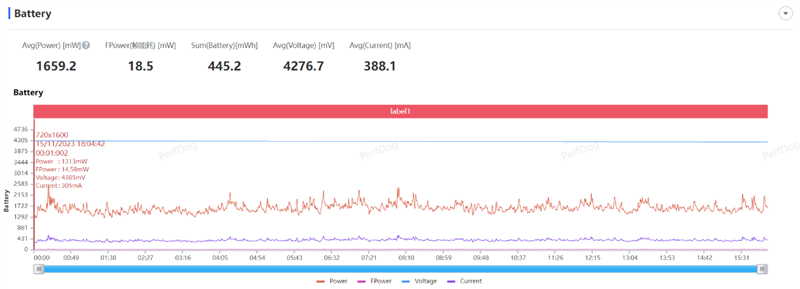
Among them, in the GeekBench 5 running score, vivo X100 took the top position, especially the multi-core running score, which is quite amazing. Obviously, the all-large-core design played a key role in it.
Let’s take a look at 3D Mark. In a single round of Wild Life, the vivo X100 scored 17134. After 20 consecutive rounds of high-intensity Wild Life, the stability was 33.3%, and the lowest cycle score was 5807.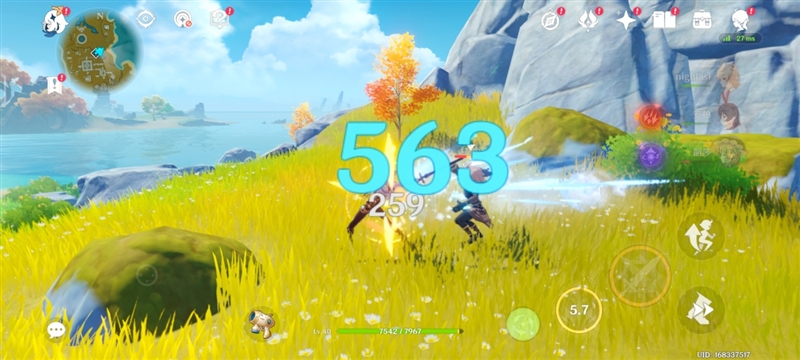
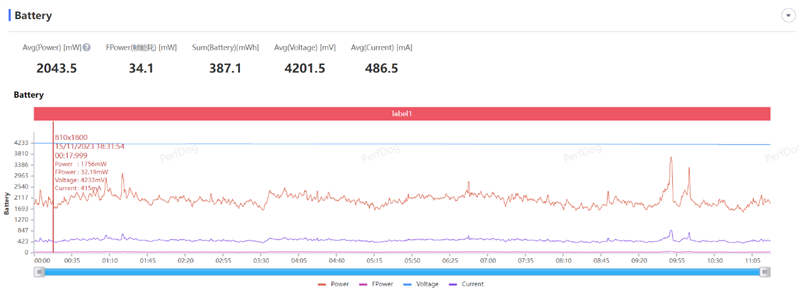
All in all, the paper performance of vivo X100 is definitely the current ceiling level, there is no doubt about this. Next, conducts actual game testing to see how the vivo X100 actually performs.
Still following the old rules, at the highest image quality + 60 frames of the “Genshin Impact” game, turn on the performance mode of the phone and conduct a 30-minute actual test.
During the test, we mainly focused on running the map, encountering monsters, and fighting them, and the combat scenes accounted for about 40% of the total game time.
The specific performance is shown in the figure below. In the 30-minute game test, the vivo X100 achieved an average performance of 60.3fps, and the lowest frame was only 51fps, which can basically be called a full frame result.
The frame rate fluctuations of “Genshin Impact” are shown in the figure below (gray):
Let’s take a look at the specific power of the full core of Dimensity 9300.
As shown in the figure, in the actual game test (basic running scene), including four super large cores and four large cores, the overall performance is basically not very powerful. The super large core occasionally reaches the top, reaching 3.25GHz, but the number of Very little, basically fluctuating around 2.6-0.8. The other four large cores basically fluctuate within 0.8GHz without exerting much power. This situation is rare. Obviously, Dimensity 9300 can handle games like “Genshin Impact” with ease.
This has to remind the author of the fear of being by “Original God” two years ago, but now I just want to say one thing – you fell down before I even exerted my strength .
In addition, in terms of temperature control, the performance of vivo X100 is also quite satisfactory. In short, during the test, the temperature never exceeded 40°C.
This performance comes from many reasons. The first is that the power consumption of the Dimensity 9300 has dropped a lot. For example, in moderate load scenarios such as “Genshin Impact” running graphics, the full core of the Dimensity 9300 does not generate much power. power, naturally there will not be too high power consumption and temperature.
Secondly, it is also related to the northern winter to a certain extent. But in the final analysis, an indisputable fact is that vivo X100 is really not very popular in scenarios such as running pictures.
In addition, the V2 self-developed imaging chip is built into the vivo, and because this is achieved through self-developed imaging chips for motion estimation and motion compensation, the GPU only needs to render 45 frames natively, which has obvious power consumption advantages compared to the native frame rate of the game. This has been tested on previous vivo X series mobile phones, so I won’t demonstrate it in detail.
Another feature is very friendly to players of “Dark Zone Breakout”. Dimensity 9300 brings full-map ray tracing to vivo X100, which is based on hardware-accelerated ray tracing technology.
Finally, I would like to add that regarding more detailed performance tests of X100 and Dimensity 9300, if there is time later, We will bring further sharing. Due to time constraints this time, I will only have a simple hands-on experience with the game. I will talk more about the author’s subjective feelings during the experience. Vivo X100 has a built-in “Blue Ocean Battery” equivalent to 5000mAh and dual-cell 120W wired flash charging.
In terms of battery life, we simply tested it. In performance mode, the X100 consumed 21% of the power in the highest quality “Genshin Impact” for 1 hour. Calculated in this way, it can bring 5 hours of heavy gaming experience, and this battery life performance is still quite good.
Cameras
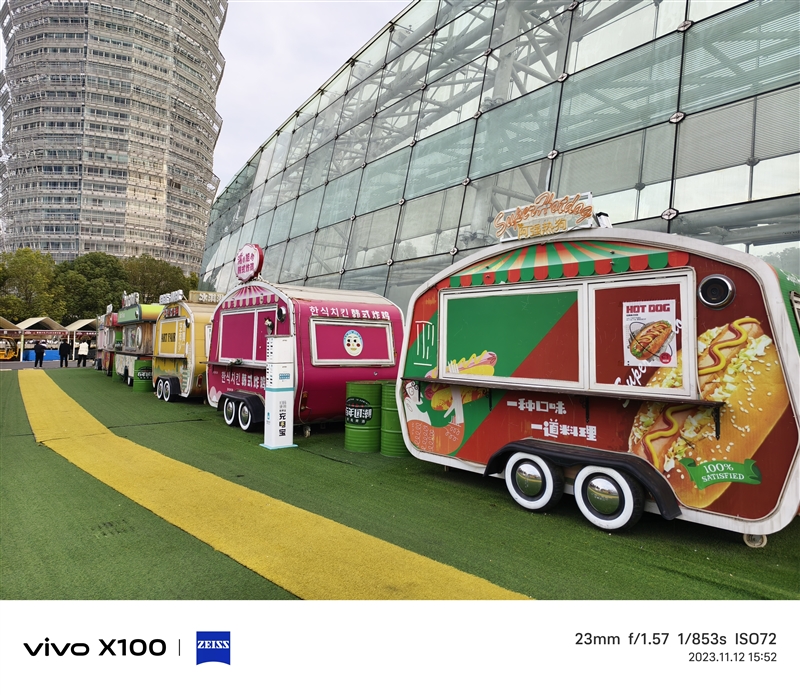
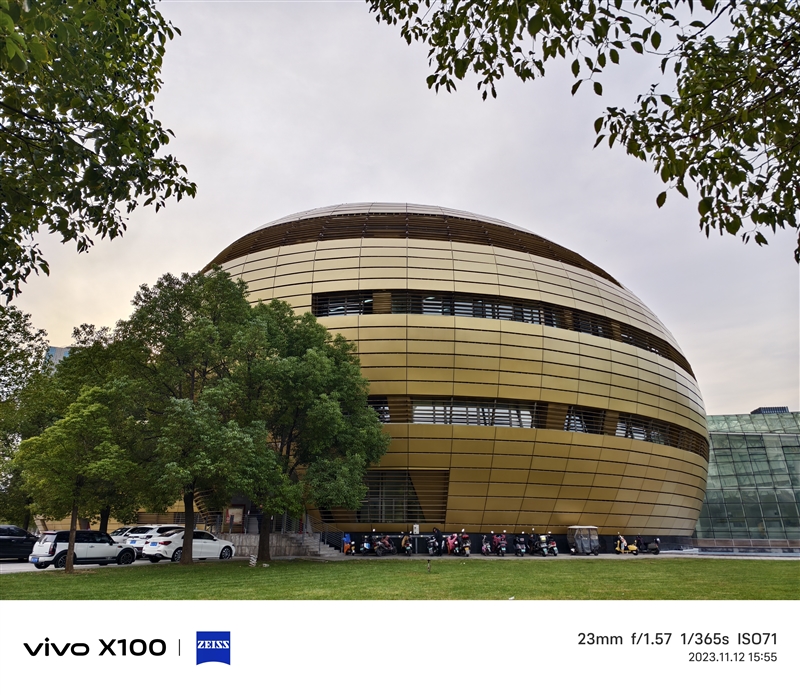
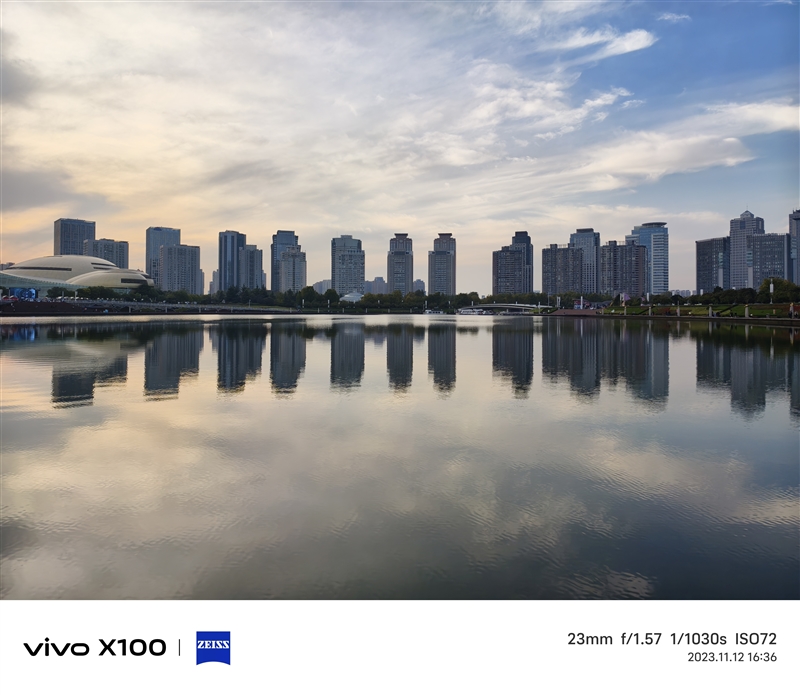
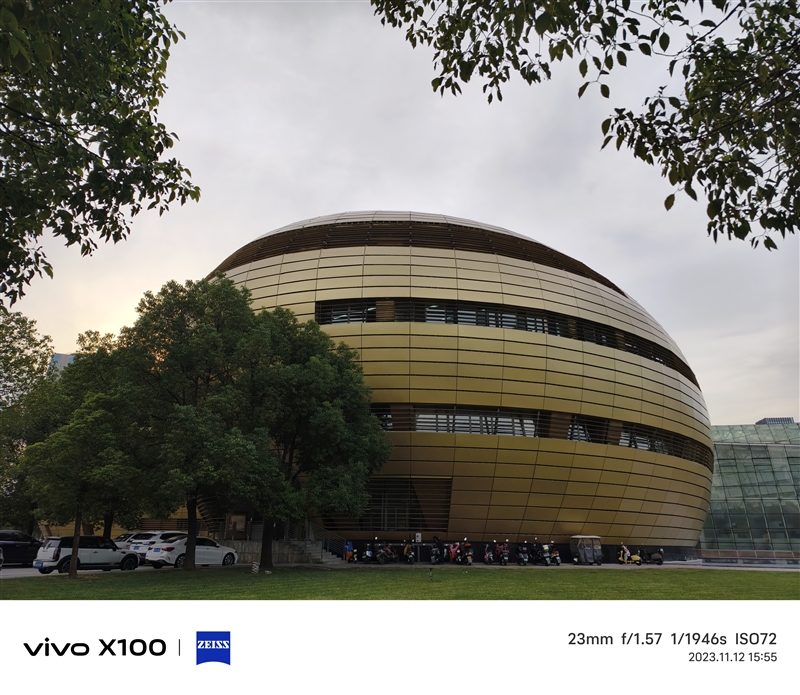
Next comes the imaging experience. Let’s talk briefly about the specifications. The standard main camera of the vivo X100 is a 50-megapixel IMX920 super-sensitive VCS bionic main camera. It has the industry’s largest aperture f / 1.57 and the amount of light intake is 24.2% higher than that of the vivo X90 main camera.
The ultra-wide angle is 50 Megapixels, 1/2.76-inch base, f/2.0 aperture, 15mm focal length, and from the specifications, it is the familiar JN1.
Here’s the key point, this time the vivo X100 standard version comes standard with a periscope telephoto lens.
Moreover, the specifications of this telephoto lens are higher than those of the X90 Pro + a year ago – they are the same OV64B, 64 Megapixels. However, the X100 upgrades this telephoto to a larger aperture of f/2.57, which increases the amount of light by 85.5%, and supports telephoto macro and 100x digital zoom.
At this time, some readers may find that vivo X100 “cut off” the most classic 2x telephoto this time. In fact, when the author first saw the configuration, I was a little confused. After all, the 2X telephoto in the vivo X series is very good at photographing people and scenery. In previous vivo reviews, this 2X portrait lens has been “criticized” by the author many times.
However, when I actually got my hands on the vivo X100, I suddenly realized that vivo directly brought 24mm (1x), 35mm (1.5x), 50mm (2.2X), 85mm (3.7X), and 100mm through lens upgrade + algorithm enhancement. (4.3x), including five professional portrait golden spots, portrait shooting directly covers the entire focal length!
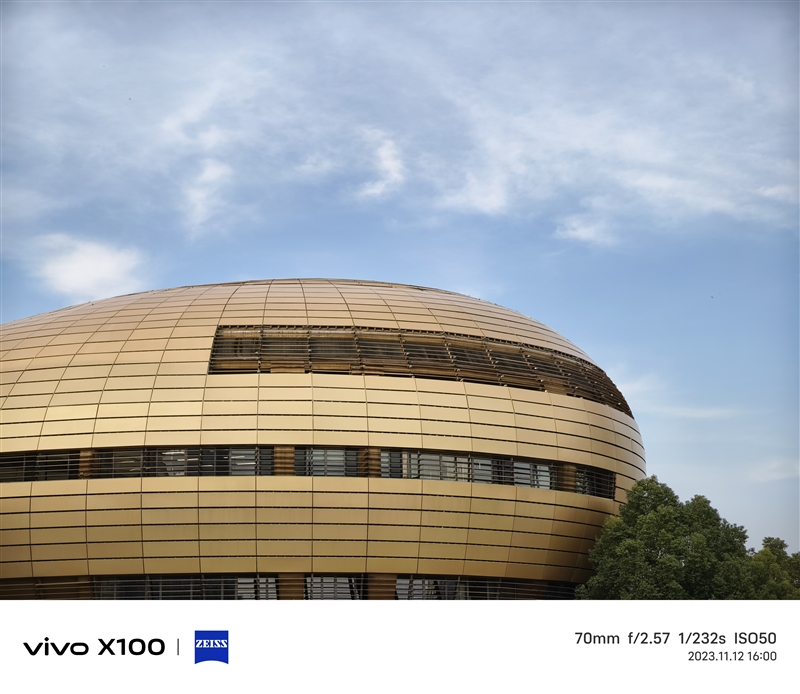
You don’t need to care at all which camera is working in these focal lengths, you just choose the focal length to shoot. To put it more bluntly, the three lenses of the vivo X100 are integrated into one, and there is no obvious separation. It is like turning into a 24-105mm large-aperture zoom lens. Therefore, it no longer matters whether there is this independent 2X portrait lens. In addition to portraits, vivo X100 also provides four focal lengths of 0.6, 1, 2, 3, and 10, corresponding to 15mm, 23mm, 46mm, 70mm, and 233mm respectively.
In terms of color, vivo X100 also provides three modes: vivid, texture, and natural. The author personally likes the texture mode, which has a stronger sense of tone and better film quality.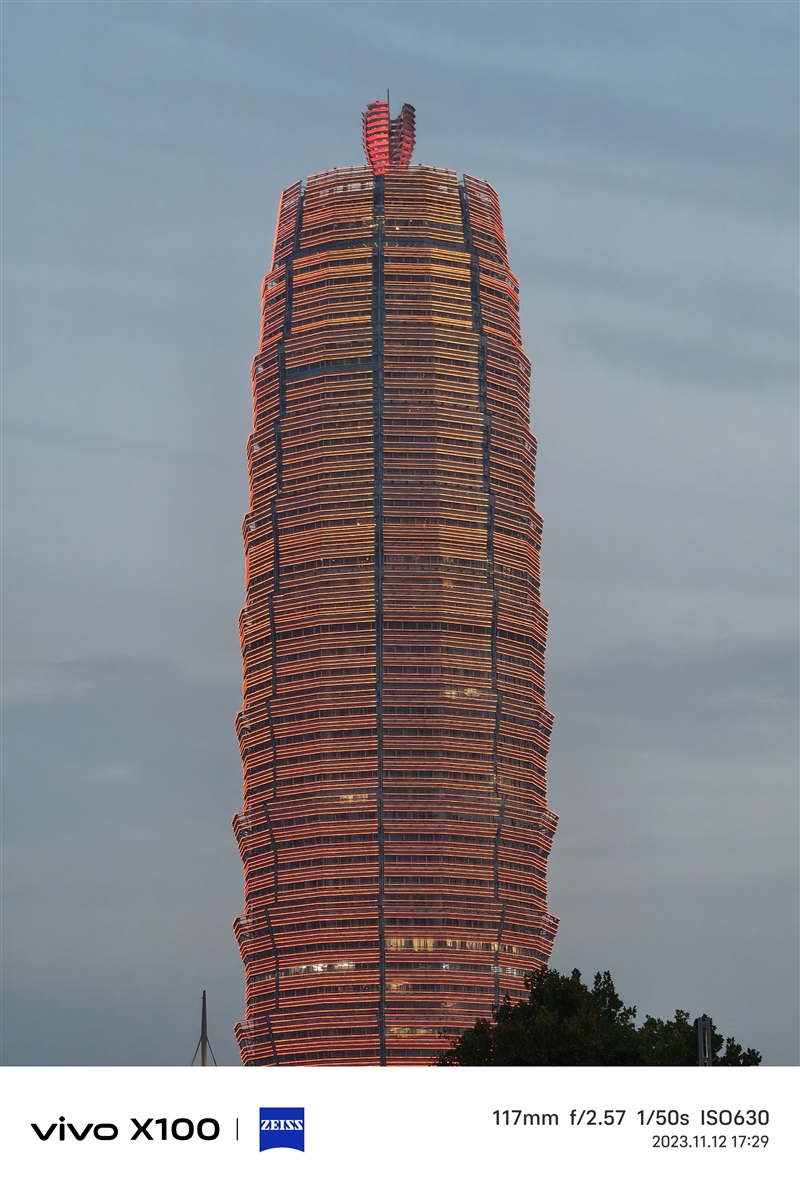
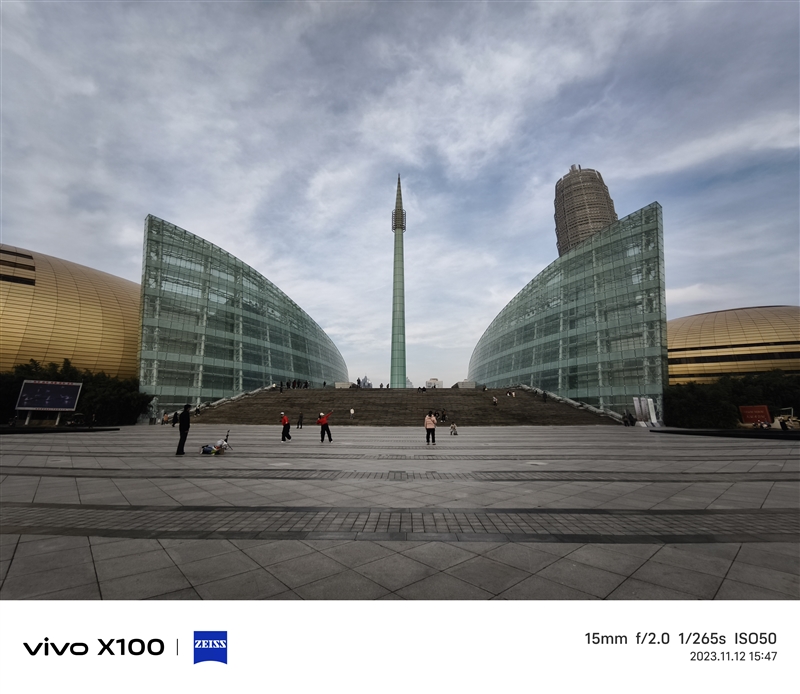
The upgrade of vivo X100 in the shooting experience, in a nutshell, is more popular and professional, with more choices and richer functions. However, to be picky, this does not seem to be very friendly to some novice photography users, because when they pick up the phone, they see various buttons on the interface, portrait lens package, color mode, and macro buttons. When you do this, you will definitely feel overwhelmed. Obviously, there is a certain learning cost to understand these things.
So a small suggestion, vivo directly gives a preset option in the shooting interface, such as novice mode and so on. But then again, photography itself is a continuous learning process. If you don’t study it carefully, how can you become a “master”?
That’s too far. Returning to the imaging experience of vivo X100, let’s take a look directly below: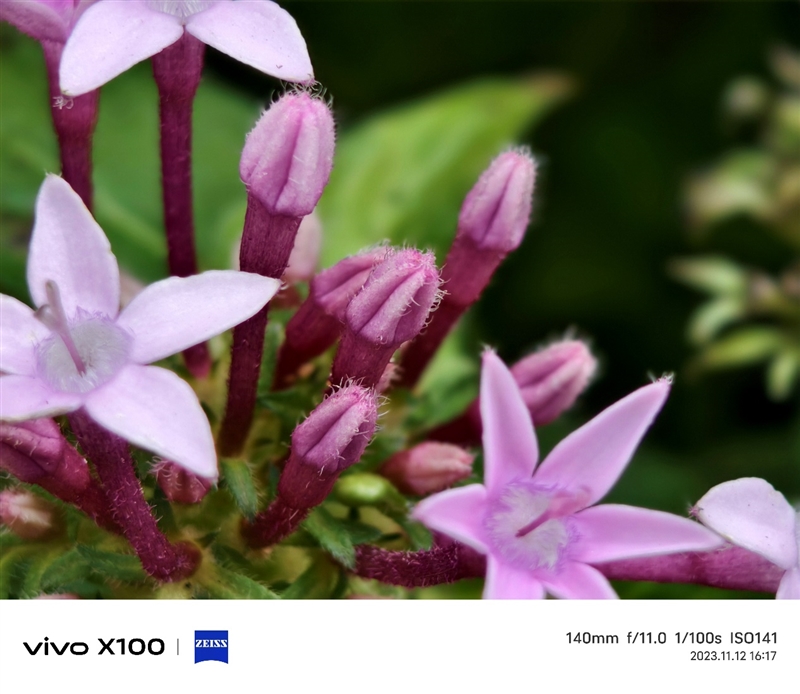
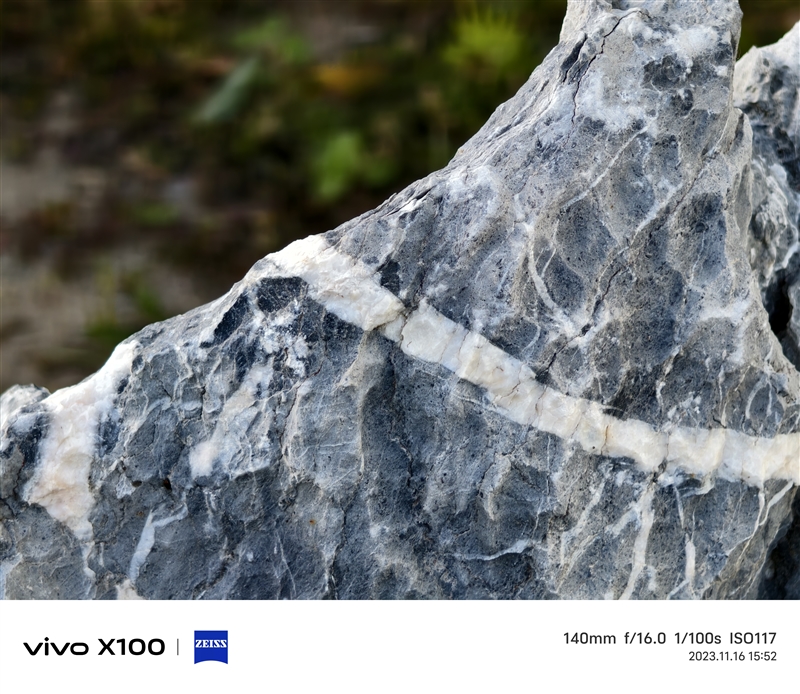
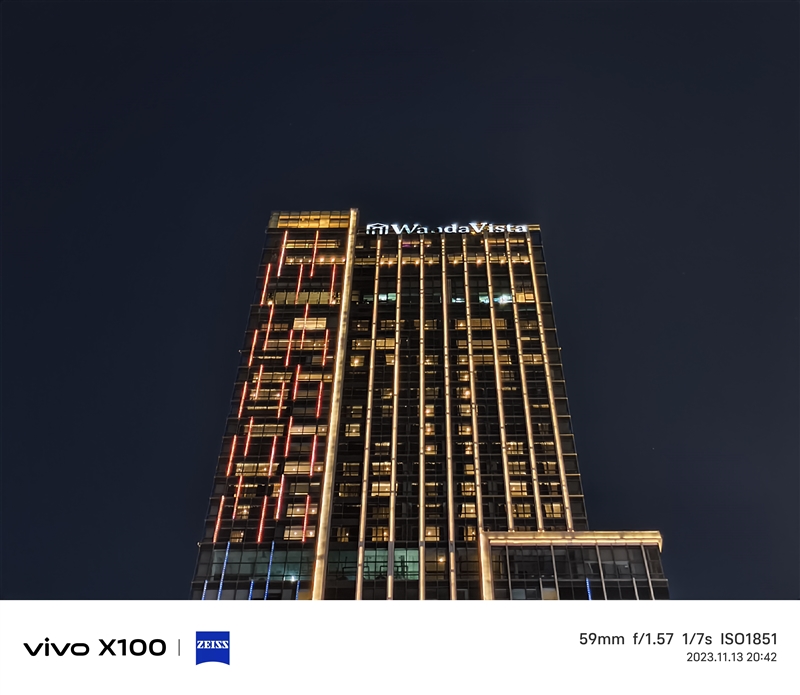
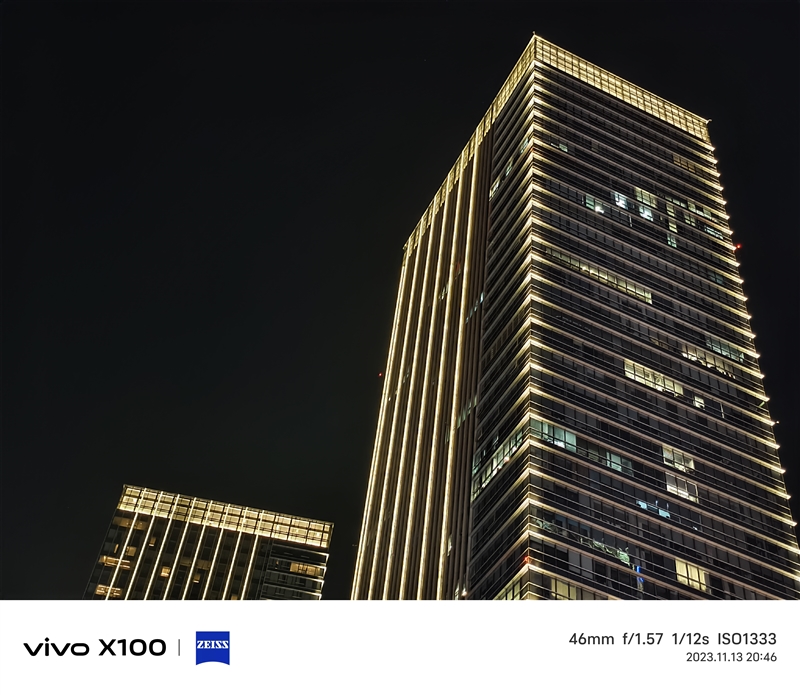
Note: The uploaded samples are all compressed, and the watermarks contain shooting parameters, which will not be noted. Judging from the sample photos, the vivo X100 has a solid flagship level, with image quality, color, details, and the consistency of the three cameras ultra-wide angle, telephoto, and main camera. Looking at the price of 3,999 yuan, it almost represents the ceiling.
In addition, in texture mode, the tone sense of vivo X100 is stronger than that of X90s half a year ago. In particular, I would like to explain that the light control and anti-glare capabilities of vivo X100 are truly unique.
For example, when shooting some neon signs, the sample looks clean and transparent, without any light leakage. Even if you are willing to manually lower the exposure slightly, even the texture and dust on the light signs can be photographed for you. , no exaggeration at all, such as in the picture below. By the way, this was taken at 10x.
When it comes to this periscope telephoto lens, in addition to its amazing detail performance in dark light, the picture quality is extremely delicate and textured when the light is good during the day. For example, in this picture, we enlarged it 100% to see the details and quality. If you don’t look at the composition and parameters, can you imagine that this was taken with a periscope?
Another surprise is the telephoto macro function brought by this periscope. To enable it, you need to click the macro icon on the interface. At the telephoto macro, you don’t need to be particularly close to the subject to produce proofs with better edge details, which is especially suitable for shooting scenes of objects such as flowers and insects that need to show rich details.
Portrait mode has always been the specialty of the X series. Vivo X100 continues the strong advantages of this family, especially the five golden portraits it brings this time, including landscape portraits, street portraits, 50mm classic portraits, portraits, and portrait close-ups. X100 covers more shooting scenes, and no longer simplifies portrait shooting.
This time, the vivo X100 also used Zeiss’s blur spot for portrait shooting and also added a new member – B-Speed style blur. In this way, when shooting portraits, you can choose the spot blur effect you want in different portrait focal lengths.
If you’re too lazy to choose, you can just choose the preset portrait lens package, which comes with specific instructions and demonstrations. The only shortcoming maybe just a little harshness from the author. As mentioned above, the overly complex interface and functions are not very friendly to photography novices.
Finally, there is Vivo’s new personalized photo frame watermark. In addition to the classic Zeiss photo frame, there are also artistic signature watermarks, personalized borders, text seals, and more.
The author likes the text seal watermark very much. It is like the final seal of a master’s painting. The font seal full of master’s flavor will directly raise the level of the photo.
OS
In terms of system, the vivo X100 series is equipped with the new OriginOS 4 for the first time. According to reports, OriginOS 4 is equipped with Blue Heart Xiao V, which has comprehensively upgraded more than 200 commonly used functions. It also designed a new weather screen and a new scene wallpaper specifically for the 8T screen. There are also wonderful and convenient digital functions: full-link parking assistant, full-link conference assistant, vivo office suite, and smart experiences such as family health manager.
In terms of UI design, the changes in OriginOS 4 are not particularly big. The experience part mainly revolves around Blue Heart V and the vivo office suite. The first is Blue Heart Little V.
According to reports, this is the first time in the industry to run through 13 billion large models, and the device side supports 7 billion large models. The vivo X100 series has also become the most powerful AI large model phone and the smartest smartphone in Vivo’s history. The AI product Lanxin XiaoV based on the Lanxin large model supports conversations with it in the most natural language. It also supports functions such as document summary, mind mapping, keyword search for photos, AI passerby invisibility, and offline summary of documents.
On the X100 mobile phone, you can quickly call out the little V through the sidebar. Click the little V icon to enter the chat window, where you can send him text, questions, photos, etc. It supports super semantic search, super A series of functions such as Q&A, super writing, picture creation, super-sensory intelligent interaction, etc.
Take Super Semantic Search as an example, it supports searching for native pictures, documents, information, schedules, Atomic Notes, native functions, etc.
For example, select a specific photo in the album and you can do it through it. Enter “Search for photos related to the machine on your phone” and these photos will appear in front of you in a matter of seconds.
For another example, if you search for text related to “kitten” in your notes, Little V can quickly find it. After opening it, the keyword “kitten” will be deepened and marked.
“Super Q&A” is similar to an encyclopedia, supporting professional knowledge Q&A, etc. “Super Writing” supports text creation, text summary, text polishing and rewriting, mind mapping and other structured text creation, and even the generation of copywriting for friend circles, copywriting for praise, holiday greetings, etc.
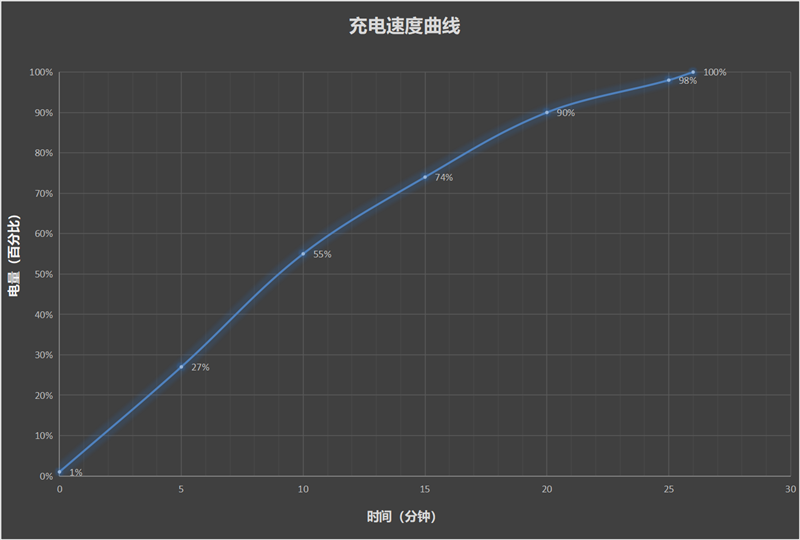
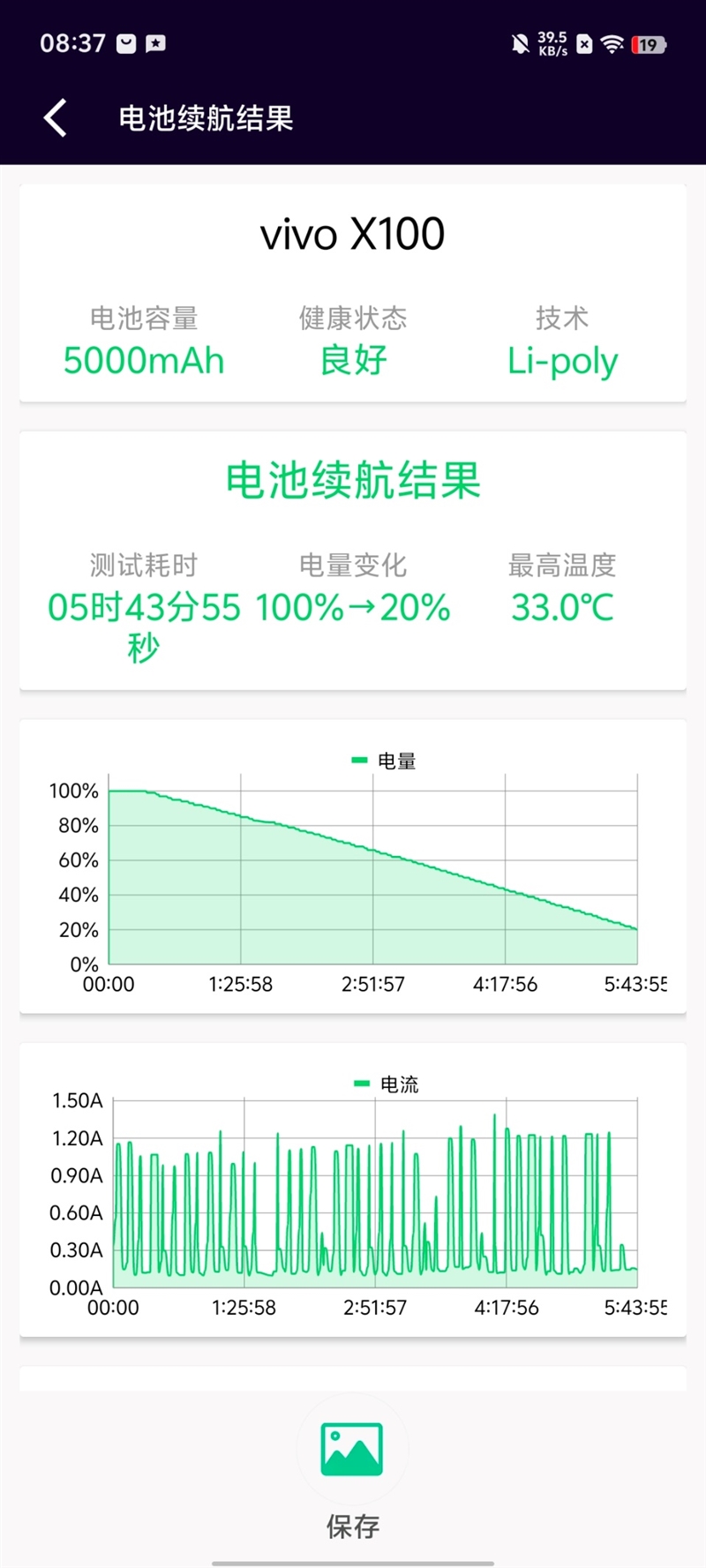
It should be noted that some of the above functions still require OTA online support in the later stage. Therefore, when testing specific requirements such as text polishing, it will display “The large model is being tuned and is not yet open.” This part will be more exciting after the X100 is officially launched. Blue Heart Little V can not only realize simple questions and answers and picture creation, but it can also understand some slightly complex instructions.
For example, if I tell it, “Book me a ticket to Shanghai tomorrow,” it will launch the Ctrip App and automatically select the ticket machine. You only need to select the flight and pay.
Another example is typing “Help me clean up junk” and it will clean up mobile phone junk. It also supports one-click screen recognition, which can perform quick text extraction, schedule creation, and other operations on the content on the screen.
All in all, the above specific demonstration is only a small part of the capabilities of Blue Heart Little V. As the subsequent large-scale model technology continues to mature, the imagination space of Blue Heart Little V will be broader.
Let’s talk about the vivo office suite again.
First of all, it has a high degree of tolerance for different platform devices. It not only supports Windows but also supports Mac and web versions. With it, you can easily connect your phone and computer to perform file transfer, cross-screen search, multi-device collaboration on notes, and other functions.
For example, in this experience article, all photo materials are transferred through the vivo office suite, which is convenient, fast, extremely stable, and the transfer speed is quite satisfactory.
Even if you take a screenshot on the mobile phone, there will be a pop-up reminder on the PC. Especially for Mac users, this is almost one of the few applications on the Mac platform that can quickly interconnect with Android phones. It is not too friendly for users who work on Mac all year round.
Verdict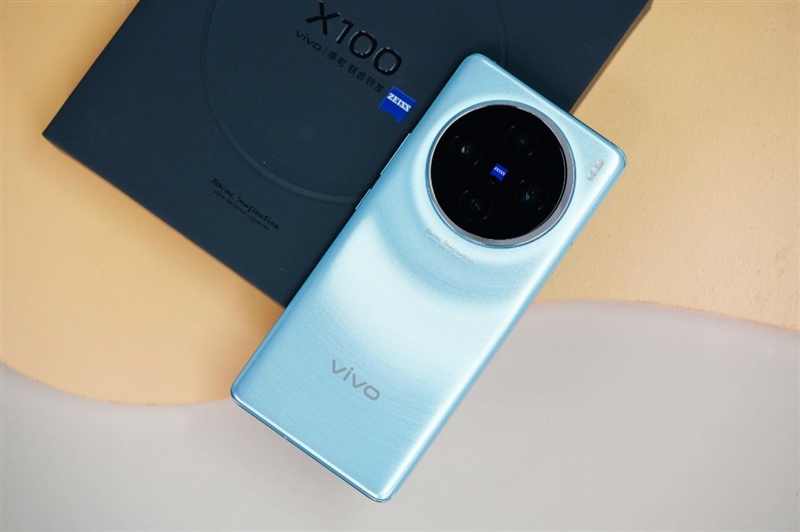
Use the title to briefly summarize the new vivo X100 mobile phone. This is a “perfect standard version, perfect imaging machine”. In the opening test of 3999 yuan, vivo handed over a very sincere “answer sheet” . After all, the previous generation product was priced at 4299 (12+256), and the X100 is 300 yuan cheaper under the premise of all-round upgrades. Therefore, the X100 does not need to be compared with anyone. The fact that it is “cheaper” than the previous generation is enough to show its sincerity.
This sincerity is also reflected in the product strength of the X100 itself: outstanding appearance and craftsmanship design, unique imaging capabilities in its class, especially the periscope telephoto and full focal length that are stronger than the X90 Pro + For portrait shooting, there are also full configurations such as the debut Dimensity 9300 (the rising power of the X100 makes the performance of the X100 unstoppable), IP68 waterproof, and the OriginOS 4 supported by Blue Heart Xiao V. It can be said that the competitive advantage of the vivo X100 Full, as a standard version product, it has indeed achieved the “perfect score” level.
You may say that the lack of wireless charging, short-focus fingerprints, and no 2K screen can be called a perfect score. In the author’s opinion, these small “regrettable” points in the 3,999 yuan range can only be regarded as “additional questions” that were not done well, or the focus is different. For ordinary consumers, this is not a problem.
All in all, the upgrade of this generation of vivo X100, especially the improvement in imaging, has indeed brought full surprises. For users who pay special attention to imaging and product design, even the standard version of vivo X100 is quite tempting.
Read Also: The first Dimensity 9300 flagship with a 1-inch master camera! vivo X100 Pro preheats











